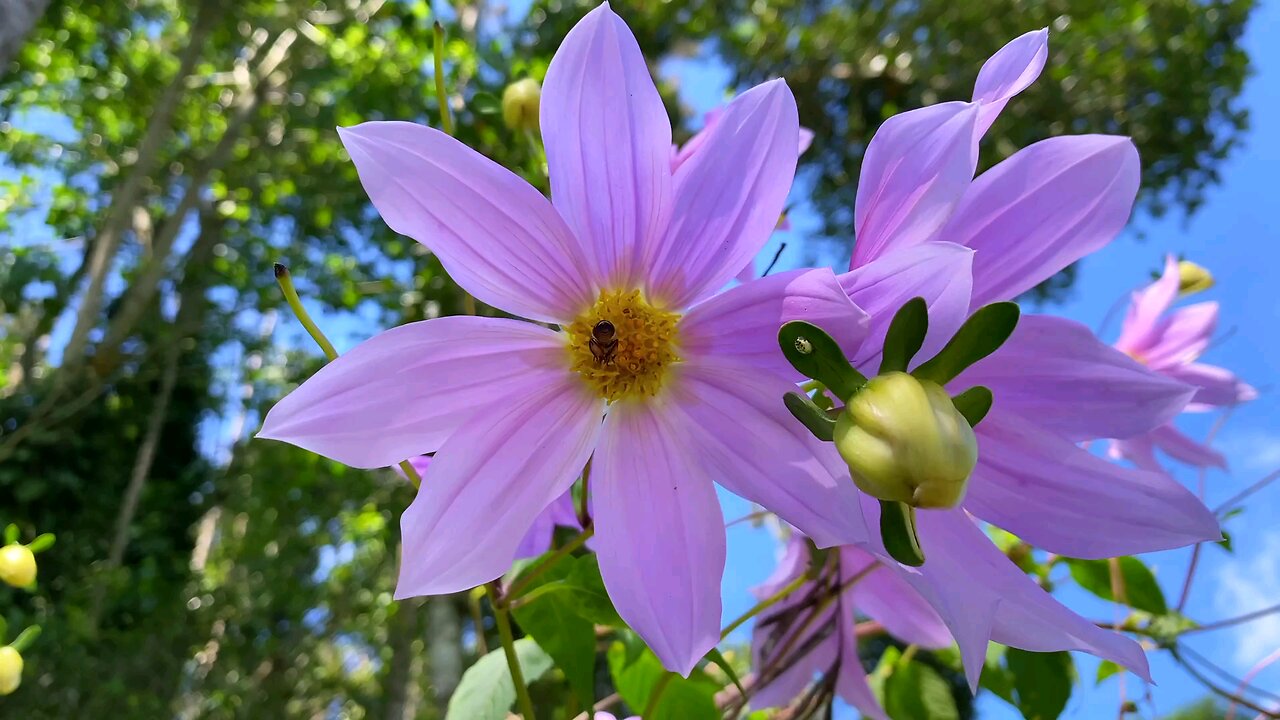Premium Only Content

"Exploring Dahlia imperialis: A Giant Among Flowers"
Dahlia imperialis, commonly known as the tree dahlia, is a towering, perennial flowering plant native to Central America, especially Mexico and Guatemala. It belongs to the Asteraceae family, which includes sunflowers and daisies. Here's an overview:
Description:
Dahlia imperialis can grow impressively tall, reaching up to 6–10 meters (20–33 feet) in height, giving it the name "tree dahlia."
The plant has hollow, bamboo-like stems and large, pinnate leaves that can grow to about 1 meter long.
It blooms in late autumn or early winter with large, pendulous, pale lavender or pinkish-purple flowers, each up to 20 cm across. The flowers resemble those of garden dahlias but grow at the tops of tall stems.
Its height and late bloom time make it a striking sight in gardens.
Habitat and Cultivation:
Native to higher elevations in Central America, Dahlia imperialis thrives in cool, mountainous regions but can be grown in temperate climates with mild winters.
It prefers well-drained soil and a sunny location. In colder climates, frost can damage its stems, so protection or growing in sheltered areas is often necessary.
Uses:
Although primarily cultivated for its ornamental beauty, Dahlia imperialis is also used in traditional Mexican medicine. The hollow stems store water, and parts of the plant are believed to have medicinal properties, though they are not commonly used in mainstream herbalism.
The plant has edible tubers, similar to other dahlia species, which have been historically used as a food source.
Cultural Significance:
In Mexican culture, tree dahlias are called "acocotli," and they have historical significance as a cultivated plant by the Aztecs.
This combination of dramatic height, beautiful blooms, and cultural heritage makes Dahlia imperialis a unique and valuable plant in ornamental gardens.
-
 3:10:10
3:10:10
Power Slap
9 days agoPower Slap 11: Da Crazy Hawaiian vs Dumpling 2 | Thursday January 30th 12pET/9aPT
3.17M52 -
 LIVE
LIVE
Dr. Drew
3 hours agoDr. Peter McCullough: RFK Jr. Faces Senate Hearing Circus, As 81,000 Doctors & Experts Publish New Demand For COVID-19 Vaccine Recall – Ask Dr. Drew
1,519 watching -
 LIVE
LIVE
In The Litter Box w/ Jewels & Catturd
21 hours agoConfirm Kash & Tulsi! | In the Litter Box w/ Jewels & Catturd – Ep. 731 – 1/30/2025
6,120 watching -
 LIVE
LIVE
PudgeTV
3 hours ago🟡 Practical Pudge Ep 52 | Sticker Mule CEO & Future NY Congressman - Anthony Constantino
434 watching -
 LIVE
LIVE
Major League Fishing
1 day agoLIVE! - Bass Pro Tour: Stage 1 - Day 1
463 watching -
 1:45:07
1:45:07
The Quartering
2 hours agoWokeness Leads To PlaneCrash, Kash & Tulsi Confirmations, Daily Wire Blasted & More
84.2K9 -
 5:56:13
5:56:13
Right Side Broadcasting Network
22 hours agoLIVE REPLAY: Kash Patel Testifies at Senate Confirmation Hearing for FBI Director - 1/30/25
432K282 -
 1:55:33
1:55:33
The Charlie Kirk Show
3 hours agoThe Biggest Confirmation Day Of All + DC Crash Aftermath | 1.30.2025
105K54 -
 6:00:23
6:00:23
vivafrei
7 hours agoKash Patel Confirmation Hearing LIVE with Moderate Viva Frei Commentary!
93.1K108 -
 LIVE
LIVE
Mally_Mouse
1 hour agoMunchies with Mally! -- Homemade Brownies & Snickerdoodle Cookies!
144 watching